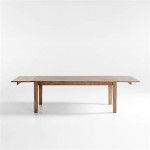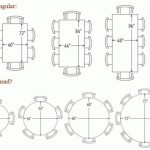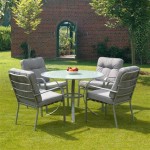Glass for Outdoor Tables: A Comprehensive Guide
Outdoor tables are focal points for gatherings, meals, and relaxation in outdoor spaces. The tabletop material plays a crucial role in the aesthetic appeal, durability, and functionality of these tables. Glass, with its sleek appearance and resilience, is a popular choice for outdoor tabletops. This article will delve into the various aspects of glass for outdoor tables, including the types of glass, factors to consider when choosing glass, maintenance, and potential drawbacks.
The selection of glass for outdoor tables extends beyond mere aesthetics. The material must withstand the rigors of outdoor environments, including fluctuations in temperature, exposure to sunlight, and potential impacts from the elements or accidental collisions. Therefore, understanding the properties of different types of glass is essential for making an informed decision.
Types of Glass Used for Outdoor Tables
Several types of glass are suitable for outdoor table applications, each offering distinct characteristics that influence its performance and suitability. The most common types include tempered glass, laminated glass, and acrylic glass. The choice depends on desired strength, safety features, and budget considerations.
Tempered Glass: Tempered glass, also known as toughened glass, is manufactured through a heating and rapid cooling process. This process creates a surface that is significantly stronger than standard annealed glass. When tempered glass breaks, it shatters into small, blunt pieces rather than sharp shards, reducing the risk of serious injury. Due to its enhanced strength and safety features, tempered glass is a frequently preferred option for outdoor table tops. It can withstand greater impacts and is less prone to cracking or shattering compared to standard glass.
The increased durability of tempered glass stems from the compressive stress on the surface of the glass, counteracting tensile stresses that can lead to fractures. This makes it suitable for environments where the table may be subject to accidental bumps or dropping of items. The safety aspect further benefits outdoor tables in areas frequented by children or pets.
Laminated Glass: Laminated glass consists of two or more layers of glass bonded together by a plastic interlayer, typically polyvinyl butyral (PVB). This interlayer holds the glass fragments together if the glass is broken, preventing it from shattering and falling apart. This characteristic makes laminated glass a very safe option for outdoor use. The interlayer also provides additional benefits such as sound insulation and UV protection.
The ability of laminated glass to remain intact after breakage is a significant advantage in outdoor settings. Even if the glass is cracked or damaged, the table top will not completely collapse, reducing the risk of injury or further damage. The PVB interlayer can also be tinted or colored, offering aesthetic customization options. The UV protection offered by the interlayer can also help to protect the table base, or items placed on the table, from sun damage.
Acrylic Glass (Plexiglass): While technically not glass, acrylic glass, also known as plexiglass, is a transparent thermoplastic that is often used as a substitute for glass. It is lightweight, shatter-resistant, and more impact-resistant than standard glass. Acrylic glass is also more flexible than traditional glass, making it less prone to cracking under stress. However, it is more susceptible to scratches and can be more expensive than tempered glass in certain thicknesses.
The lightweight nature of acrylic glass can be advantageous for tables that need to be moved frequently. Its shatter-resistance provides a level of safety that is suitable for some applications. However, its susceptibility to scratches necessitates careful handling and cleaning. Specialized acrylic glass cleaners are recommended to prevent damage to the surface. Additionally, prolonged exposure to direct sunlight can cause acrylic glass to yellow or become brittle over time.
Factors to Consider When Choosing Glass for Outdoor Tables
Selecting the appropriate type of glass for an outdoor table requires careful consideration of various factors, including size and shape, thickness, edge finishing, and aesthetic considerations. Each of these aspects contributes to the overall durability, safety, and visual appeal of the table.
Size and Shape: The size and shape of the glass tabletop will influence the type of glass needed. Larger tabletops generally require thicker glass to support their weight and resist bending or sagging. Complex shapes may also necessitate the use of tempered or laminated glass, as these types are better suited for custom cutting and offer greater structural integrity. Consider the intended use of the table and the weight it will need to support when determining the appropriate size and shape.
For example, a small, round side table might be suitable for a thinner piece of tempered glass, while a large rectangular dining table will likely require thicker laminated glass to provide adequate support and prevent cracking. The shape of the table also influences the cutting process and potential waste, which can affect the overall cost.
Thickness: The thickness of the glass is a critical factor in determining its strength and durability. Thicker glass is generally more resistant to impacts and bending, making it suitable for larger tables or tables that will be subjected to heavy use. The recommended thickness will vary depending on the type of glass, the size of the tabletop, and the support provided by the table frame. Typically, outdoor table tops range from ¼ inch to ¾ inch in thickness.
A general guideline is to use thicker glass for larger tables and thinner glass for smaller tables. However, it is essential to consult with a glass professional to determine the optimal thickness for a specific application. Using glass that is too thin can lead to cracking or breakage, while using glass that is excessively thick can add unnecessary weight and cost.
Edge Finishing: The edges of the glass tabletop should be properly finished to prevent injuries and enhance the aesthetic appeal. Common edge finishing options include seamed edges, ground edges, polished edges, and beveled edges. Seamed edges are the most basic and involve lightly sanding the sharp edges to remove any burrs. Ground edges are smoother and more refined than seamed edges. Polished edges are highly smooth and glossy, providing a more upscale look. Beveled edges add an angled edge to the glass, creating a decorative effect.
The choice of edge finishing will depend on the desired aesthetic and the level of safety required. Polished or beveled edges are often preferred for high-end outdoor tables, while seamed or ground edges may be sufficient for more casual settings. Regardless of the chosen finish, it is crucial to ensure that the edges are smooth and free of any sharp points to prevent cuts or scrapes.
Aesthetic Considerations: Glass comes in a variety of colors and textures, allowing for customization to match the overall design of the outdoor space. Clear glass provides a clean and modern look, while tinted glass can add warmth or sophistication. Frosted glass offers privacy and diffuses light. Textured glass can add visual interest and disguise minor scratches or imperfections. Consider the existing furniture and landscaping when selecting the color and texture of the glass.
For example, a clear glass table top can complement a minimalist outdoor setting, while a tinted glass table top can enhance a more traditional or rustic design. Frosted glass can be used to create a sense of privacy on a patio or balcony. Ultimately, the aesthetic choice is a matter of personal preference and should be guided by the overall design goals for the outdoor space.
Maintenance and Care of Glass Outdoor Tables
Proper maintenance and care are essential for preserving the appearance and extending the lifespan of glass outdoor tables. Regular cleaning and protective measures can help prevent scratches, stains, and damage from the elements. The appropriate cleaning supplies and techniques will depend on the type of glass and the severity of the dirt or stains.
Regular Cleaning: Regular cleaning is crucial for maintaining the clarity and shine of glass outdoor tables. Use a soft cloth or sponge and a mild detergent to wipe down the glass surface. Avoid using abrasive cleaners or scouring pads, as these can scratch the glass. For stubborn stains or dirt, use a glass cleaner specifically designed for outdoor use. It is also important to clean the table frame or base regularly to prevent rust or corrosion.
A simple solution of warm water and dish soap is often sufficient for removing everyday dirt and grime. For water spots or mineral deposits, a mixture of vinegar and water can be effective. After cleaning, dry the glass thoroughly with a clean, lint-free cloth to prevent streaks or water spots.
Protective Measures: To protect glass outdoor tables from scratches and damage, consider using placemats, coasters, and tablecloths. These items can provide a barrier between the glass surface and potentially abrasive objects. It is also important to avoid placing heavy or sharp objects directly on the glass. In areas with harsh weather conditions, consider covering the table or storing it indoors during periods of heavy rain, snow, or extreme temperatures.
During periods of non-use, a waterproof table cover can protect the glass from dirt, dust, and the elements. This is particularly important in areas with high levels of pollen or air pollution. Additionally, consider using a sealant or protectant specifically designed for glass to help repel water and prevent stains.
Addressing Scratches and Damage: Minor scratches can often be removed with a glass polishing compound. Apply the compound to a soft cloth and gently rub it over the scratched area. For deeper scratches or chips, professional glass repair services may be required. In cases of severe damage, such as cracks or breaks, the glass tabletop may need to be replaced. It is important to address any damage promptly to prevent further deterioration and ensure the safety of users.
It is advisable to consult with a glass professional before attempting to repair any significant damage to a glass outdoor table. Improper repair techniques can worsen the problem or create a safety hazard. Replacing a glass tabletop may be the most cost-effective and safest option in cases of extensive damage.

Tempered Patio Glass Table Tops Replacement For

Fab Glass And Mirror 48 In Aquatex Round Patio Table Top 3 16 Thickness Tempered Flat Edge Polished With 2 Hole Pt 48rdaq6thflt The Home Depot

Water Wave Glass Top Black Outdoor Dining Table

Fab Glass And Mirror 42 In Aquatex Round Patio Table Top 3 16 Thickness Tempered Flat Edge Polished With 2 Hole Pt 42rdaq6thflt The Home Depot

Costway 60 X 38 Patio Dining Table Glass Top Rectangular Deck W Umbrella Hole Target

Tips For Preventing Glass Table Tops From Sliding Majestic

Round Water Wave Glass Top Outdoor Dining Table Black

Makeover An Outdoor Table And Refresh Chairs Deeply Southern Home

Casainc 32 In Black Round Metal Outdoor Dining Table With Umbrella Hole And Tempered Glass Top Wf Op3685 The Home Depot

Patio Table Glass Replacement Ideas Genius








